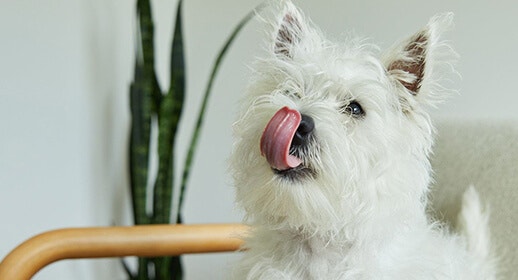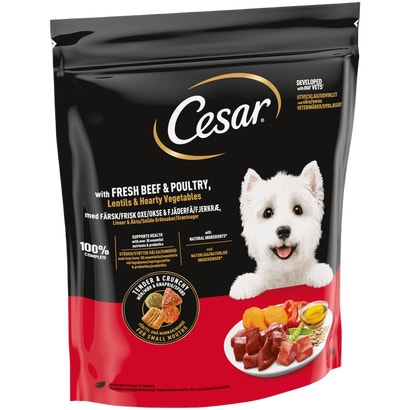- Homepage
- Discover a dog friendly world
- Dog-friendly FEEDING
- What to do if your dog is a picky eater


If you’ve tried a few different food options and your pooch is still turning their nose up at their meals, you’ve probably got a picky eater on your hands. Here’s how to deal with it.
Dogs have a reputation for eating anything and everything in their sight, and while this is the case for some greedy pooches, there are many fussy doggos out there too!
If you have a picky eater on your hands, it’s likely you’ve tried a number of tasty, nutritious food options without any luck pleasing them. You may even find that your dog won’t eat dog food, but is more than happy to accept treats and scraps of what you’re eating. We love our four legged friends to bits, but their fussy habits can be quite a challenge!
If you’re dealing with a picky eater, here are a few things that might help.
Why is my dog a picky eater?
This might not be what you want to hear, but - through all good intentions - we often train our dogs to become fussy eaters. Giving in to their begging by treating them to the occasional table scrap can make them believe there’s better food than what’s in their bowl. We also have a tendency to pander to their picky ways, by presenting them with a world of options, swapping their food for a new variety each time they turn their nose up at it.
Some other possible reasons that your dog won’t eat their food include problems with their teeth, allergies or sensitivities to food, health complications, anxiety, and even just that they’re not massively bothered about food (believe it, or not!). If you have a reason to believe your dog’s behaviour is health related, such as a sudden change in appetite or symptoms like an upset stomach, be sure to speak to a vet about your concerns.
What should I do if my dog won’t eat their food?
If your dog won’t eat their food and you’ve confirmed with your vet that it isn’t health related, there are a few things you can try to get them interested in their meals.
Try a new food or flavour
While swapping their food too often can make picky eating habits worse, it’s worth offering your pooch a few different options to see if you can find something that tickles their fancy. For example, if your dog won't eat dry food, they might prefer wet dog food or a combination of the two. You might also find they love a certain flavour or texture, such as a delicious bowl of CESAR® chicken, carrots, beans, pumpkin in gravy , duck, red rice, carrots, potato in gravy or juicy lamb and chicken terrine.
Make sure you’re not over feeding them
Another possible explanation for your dog turning their nose up at their food is that they’re just not hungry. This could be because you’re feeding them bigger portions than they need or you’re filling them up on treats and scraps. While our furry friends deserve the occasional treat, it’s important to give them in moderation to avoid weight gain and interference with their usual balanced diet. If your dog won’t eat their food but will eat treats, don’t be tempted to replace healthy meals with more treats and human foods, as these won’t offer the full nutrition they need.
Create set meal times
If your dog won’t eat their food or hasn’t finished their meal, it’s tempting to leave their bowl there so they can go back when they fancy. This can encourage picky behaviour, as your dog may use their food as backup for when they don’t get the treats they’re craving. By creating a routine where you give them their meal and remove the bowl after 30 minutes (whether the food is eaten or not), it will teach them that it’s their only option. This might sound a bit mean, but after a few days they’ll get used to the new routine and it will encourage them to eat their food, rather than holding out for something better.
Give them plenty of exercise
Sometimes it’s possible your pooch simply hasn’t worked up an appetite, so make sure they’re getting enough exercise each day. While the amount of exercise a dog needs can vary based on their breed, age and health, most healthy adult dogs need between 1-2 hours of exercise each day, including walks and some play. When they’re burning off all their excess energy, they’ll hopefully be eager for a tasty meal.
Make mealtimes more fun
Eating the same food day in, day out can become boring for our four legged friends, so mixing things up to make it more enjoyable could help regain their interest. Puzzle bowls are great for slowing down a dog that gobbles up their dinner too fast, but also for making meals more fun for dogs who aren’t usually that interested in their food. If your dog won't eat dry food you could try popping some into a food dispensing toy like a kong, so it becomes a reward rather than simply another bowl of kibble.
Give them lots of praise
Finally, the most important thing you can do when you’re training your pooch to perform a certain behaviour is to praise them. So, whenever your dog does eat their food, be sure to let them know they’ve been a good doggo.
If your dog is a picky eater, don’t give up! Try the tips above and you might find the reason for their fussy eating habits is much simpler than you imagined. If your dog still won’t eat dog food after trying a few different things, arrange to speak to your vet for further advice. You can also find plenty more tips for looking after your pooch on our dog care blog, from managing dog separation anxiety to grooming your dog or puppy.

